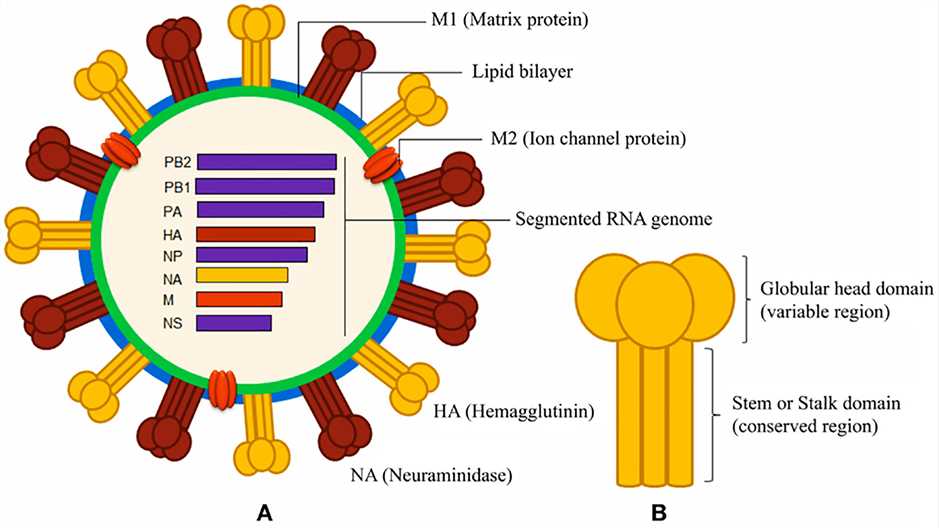Influenzavirus A Vaccines
The constant variability of viral structure is one of the challenges of seasonal influenza vaccine research. Creative Biolabs has considerable confidence in this area, and our expertise in the field of vaccines is unquestionable. Over the past 10 years, we have delivered a large number of high-quality products and services to vaccine researchers around the world, and the progress behind each vaccine research is inseparable from our outstanding contributions. If you have any needs for vaccine research, please feel free to hand over to us.
Influenzavirus A
According to the hemagglutinin (HA or H) and neuraminidase (NA or N) proteins on the surface of the virus, Orthomyxoviruses can be further divided into 7 genera, and Influenza A virus is one of them. Influenza A virus has been identified with 16 H subtypes and 9 N subtypes up to now. Due to the presence of viral variants, specific influenza virus isolates are further named according to virus type, site of isolation, isolation number, year of segregation, and H and N subtypes, such as A/Moscow/10/99 (H3N2). Influenza A virus can cause flu in birds and mammals. All subtypes of the genus are isolated from wild bird species, and some isolates can cause serious diseases to birds but are less harmful to humans. Sometimes, the spread of the virus from wild birds to poultry can cause an outbreak of the virus or increase the prevalence of human influenza.
The Influenza A virus genome is a single-stranded, segmented RNA and the viruses can be divided into different subtypes based on the number of hemagglutinin and neuraminidase proteins. There are currently 18 defined H antigens and 11 known N antigens. Each subtype of virus can be mutated into a series of strains with different pathogenicity, some of which cause disease to a particular species, while others cause disease in a variety of species.
Profiles of Influenzavirus A
Viral variants can be classified into avian flu, human flu, swine flu, equine flu, and canine flu depending on the species from which the virus is isolated. Seasonal flu, also known as annual flu, can cause approximately 36,000 deaths per year and a minimum of 200,000 hospitalizations, leading to huge economic losses. The four virus structures of Influenza type A, B, C, and D are very similar, and the virions are elliptical or filamentous in diameter of 80-120 nm. The virus is coated with an envelope containing two major proteins, hemagglutinin (HA or H) and neuraminidase (NA or N). The role of H is to mediate the binding of the virus to target cells and release the viral genome into the host cell, while N is involved in the release of progeny virions from the host cell. Therefore, these two proteins are also antigens for antibody binding and induction of immune responses. The types of H and N are the basis for further subdivision of the Influenza type A viruses subtype. There are 16 H subtypes and 9 N subtypes known, of which H1, 2, 3 and N1, 2 are common in humans. The viral genome can be divided into 8 segments and is responsible for encoding RNA polymerase, H, NP, N, matrix proteins, and non-structural proteins.
 Fig. 1 Schematic diagrams of influenza A virus and surface hemagglutinin protein. 1
Fig. 1 Schematic diagrams of influenza A virus and surface hemagglutinin protein. 1
The Development of Vaccines for Influenzavirus A
The influenza A virus subtypes that have been identified to cause a human influenza epidemic include H1N1 (Spanish flu), H2N2 (Asian flu), H3N2 (Hong Kong flu), H5N1 (global flu pandemic), H7N9 (popular in China and is considered to be the most prevalent threat subtype of influenza A virus), H7N7 (with the possibility of causing zoonotic diseases), H1N2, H9N2, H7N2, H7N3, and N10N7. In some countries, poultry has been widely vaccinated against the H5N1 epidemic. There are also some H5N1 vaccines that have been approved for use, and these vaccines are currently produced using eggs. The shortcomings of egg-produced vaccines are that the production cycle is too long to meet the large-scale needs for influenza epidemics, viruses may be fatal to chickens, etc. Therefore, mammalian cell production, cell culture production, and plant-based vaccines are currently developed for influenza vaccines.
Vaccine research is a great undertaking, and Creative Biolabs has been down-to-earth in this field for more than a decade. Our research on influenza vaccines is also well-versed. We have a large number of quality products and reliable services, which will make us your best partner for vaccine research!
Reference
- Lofano, Giuseppe, et al. "B cells and functional antibody responses to combat influenza." Frontiers in immunology 6 (2015): 336. Distributed under Open Access license CC BY 4.0, without modification.
All of our products can only be used for research purposes. These vaccine ingredients CANNOT be used directly on humans or animals.


